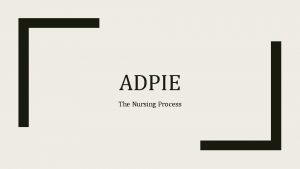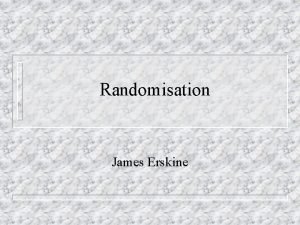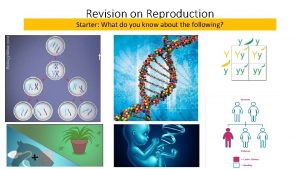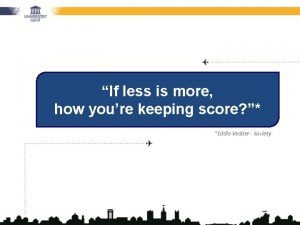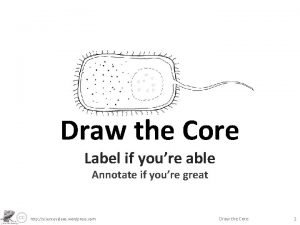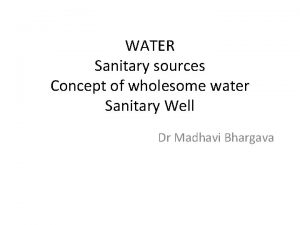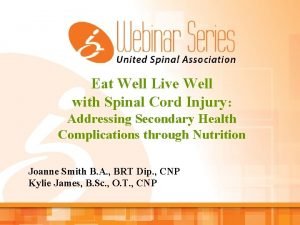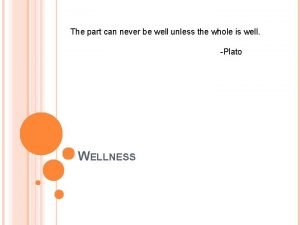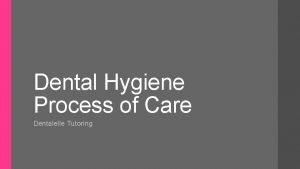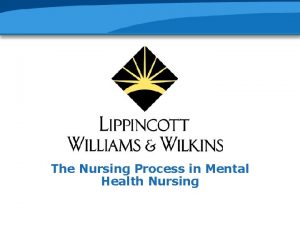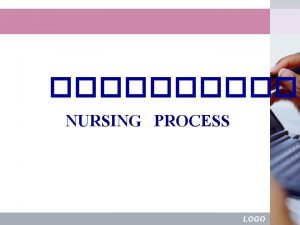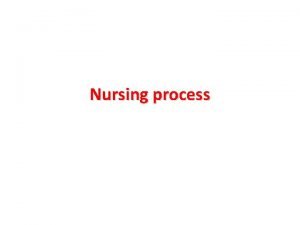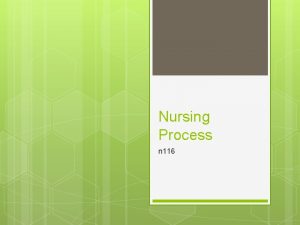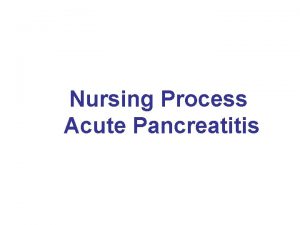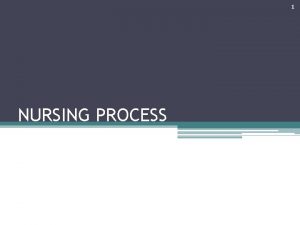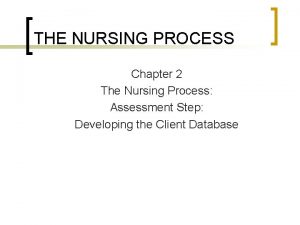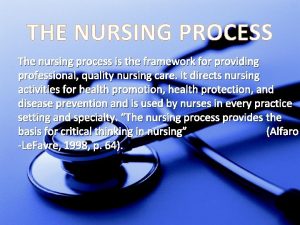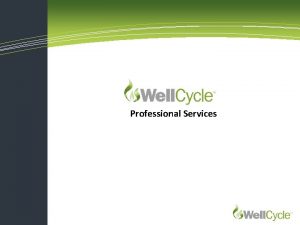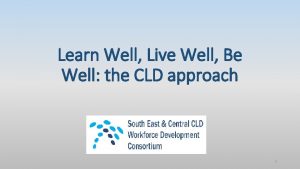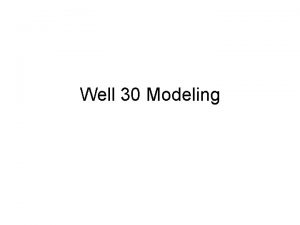ADPIE The Nursing Process Assess Well first youre




















- Slides: 20

ADPIE The Nursing Process

Assess ■ Well, first, you’re going to assess the situation (the “A” in ADPIE). ■ Why isn’t the computer turning on? Why is it all wet? And why is your thermos empty and everything smells like coffee? ■ At this stage, you are playing detective and strictly gathering data. Similarly, in nursing, this would be the stage when you first go in to see your patient, the beginning of the assessment, where we collect all the data about the patient, both objective and subjective. ■ In this case, these would be things like your first impression and vitals. What does the patient look like? Is their skin pale? Are they groaning in pain? Are their vitals stable? Is their breathing labored? Are they angry, scared, confused or delirious? Do they have a history of heart problems? What kind of medication are they taking? ■ These are all observations and data collection that you would take into account when doing an assessment on a patient. As the first step in the process, gathering all this information will allow you to proceed with the next step: your nursing diagnosis.

Diagnosis ■ Now the “D” in ADPIE stands for diagnosis, and that brings us to our next step after gathering that data that we were just presented with. ■ “Well, ” you say to yourself, “it seems to me from all my evidence here, that my coffee must’ve leaked out onto my computer, and therefore my computer is not working because it has gotten soaked with coffee!” Good deduction, detective! ■ So just like that, in our clinical assessment, we make a nursing diagnosis, where we identify actual or potential medical /health risks. The nursing diagnosis is developed by NANDA and should be prioritized based on Maslow’s hierarchy of needs. This diagnosis is key to the next step in the process: making a care plan.

Planning ■ Now that brings us to “P” in the acronym, which stands for planning. ■ When you look at your computer and have figured out the cause, you now have to make a quick plan. What are you going to do to fix the problem? You decide here that you need to run to get this computer fixed by a professional. “Let’s see, ” you think, “I have to call to see if the store is open, make an appointment, find out if my computer was backed up, leave school, take the bus to 33 rd street, walk two blocks…” ■ When we apply that to nursing, we make a plan based on the assessment and nursing diagnosis of our patient. You would then set SMART goals, which is an acronym that stands for specific, measurable, attainable, realistic and timely short-and long-term goals for the patient. From here, we can move on to the implementation part of the process.

Implementation ■ Next comes the “I” in ADPIE; the implementation portion of the process. ■ Implementation is the action part of your plan; where you actually get up and bolt to the computer store to fix this, fast! ■ Notice here the difference between the planning stage and the implementation stage. In the planning stage, you are simply forming the plan. The implementation stage is where you act on that specific plan. ■ Similarly, when we take this back into nursing, this is where we implement our plan for our patient. As the action portion of the process, this is where our plans are carried out. Implementation is the step where we finally intervene to help them, like physically giving drugs, educate, monitor, etc. After this step, we must evaluate the outcome.

Evaluation ■ And finally, we evaluate; the “E” in the ADPIE nursing process. ■ As the final step, you are done carrying out your plan, and here’s where you are waiting anxiously at the computer store, and the person helping you comes out to tell you, “Well my friend, it’s your lucky day. It was almost too late, but we saved your computer and it works like it’s brand new again. Now, remember, keep liquids far away!” ■ Hooray! ■ This would be where you ask yourself as a nurse, were we successful in making in meeting the desired outcome? Did the plan work or is it in the process of being successful? ■ If goals were not met, we need to reassess and begin the process over, noting why the goals weren’t met, and make changes to the new plan of care to make sure new goals will be completed.

Assessment ■ This 18 month old has been brought in by the mother for new onset of difficulty breathing. You will see his breathing pattern in the video. His respiratory rate is 56, his heart rate is 116, watch the video and see what else you can assess. ■ https: //www. youtube. com/watch? v=RYRu 3 d. Jj. XHk ■ Airway is open, breathing is labored with expiratory wheezing and substernal retractions. Pulse oximeter reads 92% on room air. ■ Previously healthy infant with 2 day history of fever, cough, dyspnea & vomiting. ■ Mother and both siblings have had colds. On no medication at home. Immunizations are up to date. ■ Patient is accompanied by his mother. Patient lives with mother, age 18, 2 siblings ages 2 and 3, and maternal grandmother. Patient’s father is not involved in his care. Patient’s mother appears concerned and states she did not realize that her baby was so sick. ■ No urine output for the last 8 hours. No bowel movement for 2 days

Diagnosis ■ Ineffective breathing pattern R/T increase work of breathing and decreased energy ■ Impaired Gas Exchange R/T increased secretions

Planning ■ The child will return to respiratory baseline ■ The child will not experience respiratory failure ■ The child’s oxygen status will return to baseline

Interventions—pick 5 you think go with this diagnosis ■ Maintain patent IV access ■ Monitor determinants of O 2 delivery ■ Monitor Hemodynamic status ■ Reduce oxygen consumption ■ Monitor respiratory pattern ■ Promote Orientation ■ Provide ventilator support ■ Monitor ABG levels ■ Monitor electrolytes ■ Provide oxygen therapy ■ Provide frequent oral hygiene ■ Provide med neb treatments ■ Maintain patient airway ■ Obtain sputum specimen ■ Position for adequate ventilation ■ Monitor neurological status ■ Monitor for S/S of respiratory failure ■ Monitor for loss of acid e. g. vomiting

Evaluation ■ At the end of your shift when you go back to assess the child is breathing without using accessory muscles, pulse ox reads 96% on room air. ■ Lungs with mild expiratory wheezing, improved significantly ■ No retractions noted ■ No tugging or grunting noted ■ Respiratory rate 18

Question ■ A client is getting their vital signs checked and has an oxygen saturation of 90% on RA, what should the nurse do next? a) Raise the head of the bed and re-check the oxygen saturation b) Start the client on 10 L non-rebreather mask c) Place the client on 2 L Nasal Cannula d) Contact the physician

Question ■ The nurse is caring for a client with a chest tube that was placed one hour ago. The nurse measures the amount of drainage and notes that it is 100 m. L's. What should the nurse do next? a) Call the physician b) Empty the drainage c) Nothing, this is normal d) Place the client on the side of the chest tube to encourage more drainage

Question ■ 5) The nurse just witnessed a client sign an informed consent, which of the following steps does the nurse need to take next? Select all that apply. a) Document the use of an interpreter b) Make sure the client understands the procedure and the informed consent c) Document that the client was informed of all the information before signing the document d) Make sure the document was signed with a ball point pen. e) Make sure that the informed consent is on the paper chart

Question ■ A 95 year old male reports he isn't feeling very well, but that he took all of his medications today. The nurse asks the patient when he took the medications and the patient is fuzzy on the details stating, "I don't know if I took them this morning or at lunch. " The nurse notes that the patient takes a baby aspirin everyday and metoprolol. The nurse knows that if the patient took his metoprolol multiple times by accident today that the patient could possibly have overdosed on the medication. What is the next step the nurse should take? a) Check vital signs b) Check glucose c) Assess mental status d) Call patients caregiver and ask how much the patient took today.

Question ■ Using Maslow's hierarchy of needs, a nurse assigns the highest priority to which client need? a) Elimination b) Security c) Safety d) Belonging

Question ■ A female client who received general anesthesia returns from surgery. Postoperatively, which nursing diagnosis takes highest priority for this client? a) Acute pain R/T surgery b) Deficient fluid volume R/T blood and fluid loss from surgery c) Impaired physical mobility R/T surgery d) Risk for aspiration R/T anesthesia

Question ■ Once a nurse assesses a client’s condition and identifies appropriate nursing diagnoses, a: a) Plan is developed for nursing care. b) Physical assessment begins c) List of priorities is determined. d) Review of the assessment is conducted with other team members.

Question ■ The nurse writes an expected outcome statement in measurable terms. An example is: a) Client will have less pain. b) Client will be pain free. c) Client will report pain acuity less than 4 on a scale of 0 -10. d) Client will take pain medication every 4 hours around the clock.

Question ■ The planning step of the nursing process includes which of the following activities? a) Assessing and diagnosing b) Evaluating goal achievement. c) Performing nursing actions and documenting them. d) Setting goals and selecting interventions.
 Adpie nursing process example
Adpie nursing process example Writing a mail
Writing a mail Hello everyone
Hello everyone How to act angry
How to act angry Jesus you're my firm foundation i know i can stand secure
Jesus you're my firm foundation i know i can stand secure You're so random
You're so random Jesus
Jesus Cybersmart definition
Cybersmart definition What are the signs of an asexual person
What are the signs of an asexual person Acrostic poem happy
Acrostic poem happy If less is more how you keeping score
If less is more how you keeping score Tentative goal statement
Tentative goal statement Youre able
Youre able And the tree was happy but not really
And the tree was happy but not really Nursing diagnosis format
Nursing diagnosis format Nursing process in psychiatric nursing
Nursing process in psychiatric nursing Wholesome water definition
Wholesome water definition Eat well stay well
Eat well stay well Diet for spinal cord injury patient
Diet for spinal cord injury patient The part can never be well unless the whole is well meaning
The part can never be well unless the whole is well meaning Well defined sets examples
Well defined sets examples
